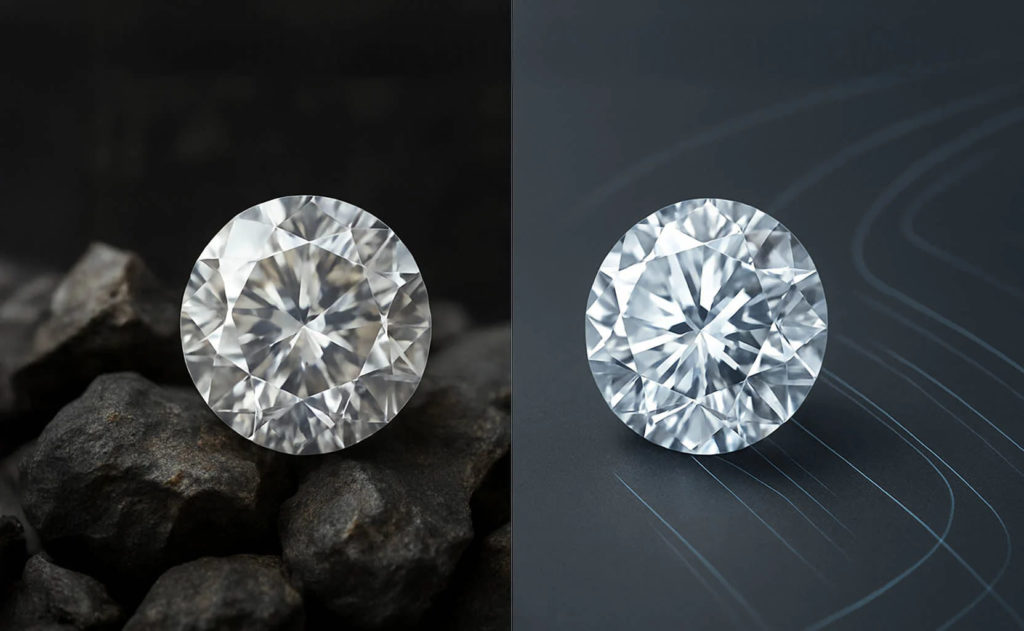Diamonds have always symbolized love, luxury, and timeless beauty. But today, shoppers face a modern question — should you choose lab-grown or natural diamonds? Both shine brilliantly, but their origins, price, and environmental impact tell very different stories. Understanding these differences can help you make a purchase that aligns with your values and budget.
Understanding the Basics: What Are Natural and Lab-Grown Diamonds?
Before diving into the comparisons, it’s essential to know what sets these two apart at their core.
Natural diamonds are formed deep within the Earth over billions of years under immense heat and pressure. They’re mined from the Earth’s crust, often in countries like Russia, Botswana, and Canada. Each natural diamond is unique — a rare geological masterpiece.
Lab-grown diamonds, on the other hand, are created in high-tech laboratories using advanced techniques that replicate the natural diamond-growing process. They are chemically, physically, and optically identical to natural diamonds. The main difference lies in their origin — one comes from the Earth, and the other from a lab.
How Are Lab-Grown Diamonds Made?
There are two main methods to create lab-grown diamonds:

1. High Pressure High Temperature (HPHT)
This process mimics the natural conditions under which diamonds form. Carbon is subjected to high pressure and temperature until it crystallizes into a diamond.
2. Chemical Vapor Deposition (CVD)
In this modern technique, a small diamond seed is placed in a chamber filled with carbon-rich gas. The gas breaks down, and carbon atoms settle on the seed, forming a diamond layer by layer.
Both methods produce stunning, real diamonds — not imitations or simulants like cubic zirconia or moissanite.
Appearance and Quality: Can You Tell the Difference?
One of the biggest questions people have is whether lab-grown and natural diamonds look different.
To the naked eye, they are virtually identical. Both share the same sparkle, fire, and brilliance. Even professional jewelers often need specialized equipment to distinguish them.
When it comes to grading, both types are evaluated using the same 4Cs:
- Cut – Determines brilliance and sparkle.
- Color – Ranges from colorless to slightly yellow.
- Clarity – Refers to internal or external flaws.
- Carat Weight – The size or weight of the diamond.
Reputable labs like GIA and IGI grade both natural and lab-grown diamonds using identical standards, ensuring transparency for buyers.
Cost Comparison: Why Lab-Grown Diamonds Are More Affordable
One of the main reasons people choose lab-grown diamonds is cost.
Lab-grown diamonds can be 30–50% cheaper than natural ones of similar quality. This price difference comes from the shorter supply chain and the absence of mining costs.
For example, a 1-carat natural diamond might cost $6,000, while a lab-grown diamond of the same quality could be around $3,000. This allows couples to buy larger or higher-quality stones within the same budget.
However, it’s important to note that natural diamonds often retain higher resale value due to their rarity, while lab-grown diamonds can depreciate faster.
Environmental and Ethical Impact
Sustainability plays a huge role in today’s diamond market.
Natural Diamonds: The Environmental Cost
Diamond mining can have significant environmental impacts — including soil erosion, deforestation, and water pollution. Although many modern mines are regulated, the industry still faces ethical challenges regarding labor conditions in some regions.
Lab-Grown Diamonds: A Greener Alternative?
Lab-grown diamonds are often marketed as eco-friendly because they don’t involve mining. However, they still require significant energy, especially electricity. Some labs now use renewable energy sources to make the process cleaner and more sustainable.
If environmental responsibility is your priority, look for brands that are certified carbon-neutral or use sustainable practices in their production.
Symbolism and Emotional Value
For many, the emotional value of a diamond goes beyond science and sparkle.
Natural diamonds are prized for their rarity and the fact that they took billions of years to form. They often symbolize enduring love and the passage of time.
Lab-grown diamonds, however, appeal to modern values — innovation, ethics, and sustainability. They represent love that’s forward-thinking, conscious, and environmentally aware.
Ultimately, the emotional connection comes from personal preference and the story behind the stone you choose.
Durability and Longevity: Are Lab-Grown Diamonds as Strong?
Both lab-grown and natural diamonds score a 10 on the Mohs hardness scale, making them the hardest known material on Earth. This means both types resist scratches and damage equally well.
With proper care, lab-grown diamonds will last a lifetime — just like their natural counterparts. Whether set in engagement rings, earrings, or necklaces, both retain their beauty and brilliance for generations.
Investment Value: Should You View Diamonds as an Asset?
If you’re buying a diamond purely for investment, natural diamonds still have the upper hand. Their rarity and market history make them more likely to hold or appreciate in value over time.
Lab-grown diamonds, while beautiful, are not considered investment-grade due to their lower resale value and increasing production capabilities, which reduce scarcity.
That said, most people buy diamonds for sentimental rather than financial reasons — and in that regard, both types deliver lasting emotional value.
How to Choose Between Lab-Grown and Natural Diamonds
The choice depends on your priorities:
- Choose lab-grown diamonds if you value affordability, sustainability, and ethical sourcing.
- Choose natural diamonds if you appreciate geological rarity, tradition, and long-term value.
Before purchasing, always ensure your diamond comes with a trusted certification from GIA, IGI, or another reputable body. This ensures authenticity and transparency about the diamond’s origin and quality.
Read Also : Jewellery as an Investment: Do Diamonds and Gold Still Hold Value?
Final Thoughts
The debate between lab-grown and natural diamonds isn’t about which is better — it’s about which is right for you.
Lab-grown diamonds offer the same stunning beauty at a fraction of the price, appealing to eco-conscious, modern consumers. Natural diamonds, on the other hand, carry the allure of rarity and timeless tradition.
Whether you choose Earth-mined or lab-created, your diamond’s brilliance will always reflect your personal story — one that shines with love, values, and individuality.

